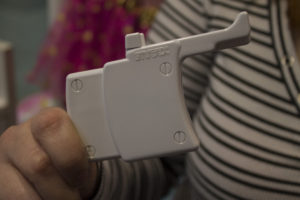Newfoundland has one professional piercer on the Avalon Peninsula. She tells us the difference between piercing with guns and needles.
Margaret Harvey
Kicker

Today’s society has pinned the idea of pierced ears on little girls as the norm.
Nicole Fifield, a mother of an almost 21-month-old daughter, had her little girl’s ears pierced at four months old.
“I just thought it would look cute, and the earlier the better, you know? Because she wouldn’t have the sense to pick at them – to spread infection or anything,” Fifield said.
Her daughter’s ears were pierced at a store in the Avalon Mall by someone using a piercing gun. The little girl did not experience any of the potential hazards associated with piercing guns in the ensuing weeks. However, experts say it’s safer to be pierced with a needle than with a gun.
Renee Sigurdson attended a continuing educational conference hosted by the Association for Professional Piercers (APP) and is the only person on the Avalon Peninsula that has attended. She aims to be a member of the association someday soon. When Sigurdson began her training 13 years ago at a local mall, she was trained with a gun and practised on a sponge for two hours before she did her first piercing on a child. She believes piercing guns should not be used on children.
“It’s just not right,” she said.
“When you get pierced by a gun, there is no way for that gun to be autoclaved (sterilized in a heated container),” she said. “You can wipe (the gun) down with alcohol, but that can only get so much.”
The guns are made of plastic and would melt in an autoclave.
Sigurdson went on to explain how hepatitis can stay on a surface for two weeks. If someone with hepatitis gets their ears pierced with a gun, that person can potentially contract infections or disease if the gun is not sanitized properly. This risk also goes for AIDS and other blood-borne infections.
Although this information is known, some parents are either unaware or do not share Sigurdson’s concern. Fifield, for example, was happy with the precautions taken by the person who pierced her daughter’s ears with a gun.
“The gun itself, to me, didn’t cause any concern because her ears were disinfected, and the earrings were disinfected before ever touching her,” Fifield said.
Blunt-force trauma
However, even if piercing guns were to be disposable, this would not change the issue of the blunt-force trauma it causes. Sigurdson compared it to taking a blunt earring and trying to force it through your ear.
“They’re putting trauma into it to create that actual wound,” Sigurdson said. However, when a needle is used, it carves out a little piece of your skin so there is a place for your jewelry to sit in, causing less trauma on the body.
According to the Association of Professional Piercers, a piercing gun can crack or shatter the cartilage in the ear completely. Although the damaged cartilage can be pierced again, it will take much longer to heal, be more painful, and there is a risk your body will the reject the piercing.
Sigurdson understands parents’ desire to pierce their children’s ears, but she has a set of rules for piercing children: “(The children must) repeat back the aftercare with me, they can sign their own name, and they can sit by themselves. It shows that they are able to comprehend what they’re doing,” she said.
Sigurdson also wants to ensure children are able to clean the piercing themselves, as their first instinct is to touch it.
“If I had my time back, myself, I’d do a bit more research ’cause I was not aware of (the potential dangers),” said Fifield. “And being aware of it now I’d probably tell somebody, you know, like, ‘Hey check it out, weigh out your options,’ that kind of thing.”
Additional information about safe piercings can be found on the Association of Professional Piercers website.




Be the first to comment